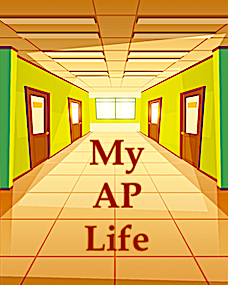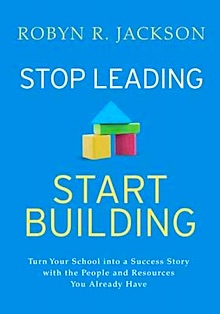Robyn Jackson’s Vision of School “Buildership”
A MiddleWeb Blog
 For me, leadership has always been about leading the way for teachers. Letting them know that I would never ask them to do anything that I wasn’t willing to do. Being a model of the expectations at our school.
For me, leadership has always been about leading the way for teachers. Letting them know that I would never ask them to do anything that I wasn’t willing to do. Being a model of the expectations at our school.
And I’ve always thought this was enough.
However, after reading Robyn Jackson’s latest book – Stop Leading, Start Building! Turn Your School into a Success Story with the People and Resources You Already Have – I realize that to truly change a school, I can’t just lead it, I must help in building it.
Right away, Dr. Jackson makes a bold statement: Leadership was created by the institution. It’s designed to maintain the institution, not transform it. I’ve always strived to be a transformative leader, but I realize I haven’t been all that successful. This one statement resonated with me and made me want to read more.
According to Jackson, leadership is a great place to start, but it only holds you accountable for most of your staff and students. It allows you to find excuses for the few who don’t meet the expectations. It allows you to look for ways to get rid of those on staff who are often in the thick of the school drama and problems.
On the other hand, Buildership makes you accountable for ALL of your staff and students. It requires that you set a vision, mission, and core values that truly exemplify the beliefs of yourself and your staff – beliefs about what you want from your students. It makes you look for ways to incorporate the staff you have now into the process to get complete buy-in.
Jackson’s premise uses four key areas called the Buildership Model: Purpose, People, Pathway, and Plan. In her book she delves deep into each area explaining the how, the what, and more importantly the WHY. I’ll summarize some key points here.
PURPOSE
Jackson starts us on our journey into becoming Builders with her first key area, Purpose. She states that creating a compelling purpose, “get[s] [us] off the ‘school improvement hamster wheel.’” A clear and compelling purpose answers three questions that staff ask: (1) What are we building?; (2) Why is it important?; and (3) What role does each of us play?
Vision
Creating a clear and exciting vision answers the question “what are we building?” Jackson calls this the school’s rallying cry. When developing this, we need to be thinking about how we can ensure that we are including all students in the vision, and thow we can be sure the vision is exciting for not only us but our staff, students, and parents.
Jackson asks us to use three questions when developing our new vision: (1) what makes our district/school special? (2) when everything is working well, what does it mean to our students? and (3) does our new vision truly include all students? According to Jackson, “When you set a 100-percent vision for your students…you can’t just tweak your way to improvement. You have to reconsider everything.”
Mission
Once our vision is set and includes 100 percent of our students, Jackson asks us to create our mission. This answers the question, why what is we are building important? In the book she references Simon Sinek’s idea of starting with the why. She states that there is “an important difference between writing a mission statement and establishing a school mission.” When you establish a school mission, the conversations become more about everyone’s why and less about wordsmithing a paragraph to make it sound good.
While the vision should be created by the leadership team, Jackson says that the mission should be established with the entire staff’s input after the vision has been shared. She includes several guiding questions to help administrators lead conversations about establishing a mission. She ends the section by reminding leaders that although everyone inputs on the mission, we need to make sure that our mission is directly connected to our vision.
Core Values
Finally, in the area of purpose, Jackson has us begin the work of defining our core values as they relate to our new vision and mission. She states that builders do two things to create core values that are “powerful and useful.” They “make them non-negotiable” and they get everyone’s buy-in.
Core values should be created with everyone, in much the same way we establish the mission. Co-creating the core values with staff ensures that they buy in to them and helps them accept that they are non-negotiable because they will want them to be non-negotiable as well.
PEOPLE
The next area of focus in the Buildership Model is people. Jackson truly believes that you can achieve your vision and mission with the staff you have right now. As a matter of fact, the subtitle of this section is “How to have an entire staff of master teachers (without having to “get rid” of anyone).” She challenges us to dig deep into our evaluation rubrics and create a chart that compares proficient teachers with master teachers.
Jackson notes that in most evaluation rubrics the major difference between the two is that proficient teachers “will understand and reach most students” while a master teacher “reaches all students.” In one of the examples in the book, she gives us a chart that breaks down the markers of a proficient teacher and a master teacher.
Under the area of people, Jackson gives us four disciplines that will help us improve all teachers’ will and skill: clear and precise feedback, intentional and differentiated support, focused accountability, and positive and nurturing school culture. She notes that many times feedback is given with a laundry list of little fixes that teachers are supposed to work on. Jackson challenges us to instead use the One-Thing method of feedback.
In addition to one-thing feedback, Jackson challenges us to differentiate our support based on a teacher’s needs and where they are in terms of skill. She encourages us to develop a teacher dashboard in which we keep track of the feedback given, the focus of the support, the type of support we are giving, and any additional notes we need to make. Using this helps hold ourselves accountable for the professional growth of all our teachers including those who are already at the master level.
PATHWAY
The third area of the Buildership Model is pathway. During this phase, builders examine where school improvement went wrong, find the right thing to work on, and then begin the process of building in that area. Jackson says we need to find our weakest link and focus on improvement in that area instead trying to improve in multiple areas at one time.
She tells us to make a Builder’s Blueprint that includes our vision, mission and core values to ensure that we keep these in mind as we tackle improvement in our weakest area. She gives us a new way to look at data and to use data as we build our pathway to success.
Jackson gives a template of a Builder’s Blueprint in this section including an “if/then/therefore” statement we can use to help share this blueprint with our entire staff. These blueprints lay out the plan of “transformative actions” for the 90 days that we will undertake to get us to our goal.
PLAN
Finally, Jackson lays out for us how to really get the work done in 90-day increments. According to her, “Ninety days in long enough to build up momentum and short enough to allow you to adjust your trajectory if something threatens to seriously affect your plan.” Creating a 90-day plan has six stages: excite, explore, engage, expect, evaluate, and extend. She delves deep into each of these, giving us practical advice for how to plan and then execute them stage by stage.
Finally, Jackson tells us that we need to stick with our plan despite obstacles that may happen and introduces us to a concept called Meeting Rhythm. Using this method, “you’re not meeting for the sake of meeting; you’re meeting to consistently confront and solve issues before they derail your progress.”
In her final chapter, Jackson acknowledges that the work of a builder using these four areas is not something that will be completed in one year. She says – depending on our school culture, size, and ability to focus – the process can take anywhere from 18 months to 3 years to complete.
This model is not designed to replace our old model. It is not a one-size-fits-all approach either. Instead, it is a approach that, if used the way it is designed, will transform not only our schools but also our way of thinking.
Implementing Buildership at my school
As an assistant principal, I know that my reach is a bit limited and that it is ultimately my principal who will make the major decisions for our school. However, as Dr. Jackson said in a webinar I attended last week, I can start with what I have. I am in charge of a few programs at our school, and I can begin using what I’ve learned from her book in those areas.
How much more effective would our RTI program and process be if I used these ideas to reshape and transform it? How much more support would new teachers to our school feel if I begin using these principles to create a program that differentiates their support?
Using Jackson’s ideals and this book’s framework where I can right now will only build my comfort level so that when I have my own school I can continue the transformative work that I started as an assistant principal.





































Thank you, DeAnna. What a great post! I can just see you engage in “buildership”–love that term! I miss seeing and hearing you!